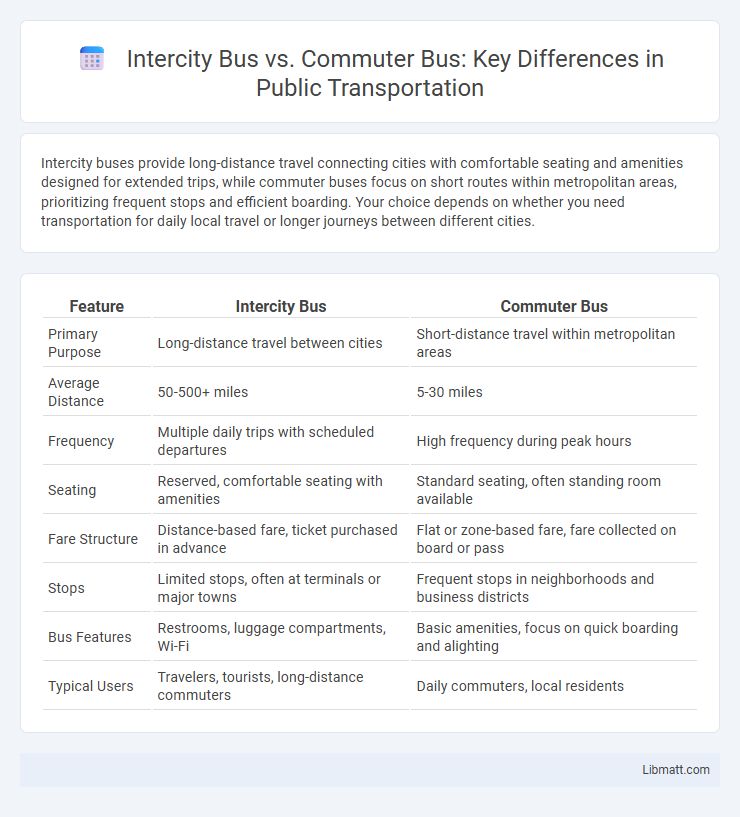Intercity buses provide long-distance travel connecting cities with comfortable seating and amenities designed for extended trips, while commuter buses focus on short routes within metropolitan areas, prioritizing frequent stops and efficient boarding. Your choice depends on whether you need transportation for daily local travel or longer journeys between different cities.
Table of Comparison
| Feature | Intercity Bus | Commuter Bus |
|---|---|---|
| Primary Purpose | Long-distance travel between cities | Short-distance travel within metropolitan areas |
| Average Distance | 50-500+ miles | 5-30 miles |
| Frequency | Multiple daily trips with scheduled departures | High frequency during peak hours |
| Seating | Reserved, comfortable seating with amenities | Standard seating, often standing room available |
| Fare Structure | Distance-based fare, ticket purchased in advance | Flat or zone-based fare, fare collected on board or pass |
| Stops | Limited stops, often at terminals or major towns | Frequent stops in neighborhoods and business districts |
| Bus Features | Restrooms, luggage compartments, Wi-Fi | Basic amenities, focus on quick boarding and alighting |
| Typical Users | Travelers, tourists, long-distance commuters | Daily commuters, local residents |
Overview of Intercity and Commuter Buses
Intercity buses provide long-distance travel between cities with scheduled stops, designed for comfort and luggage space, making them ideal for extended trips. Commuter buses serve shorter routes, typically connecting suburbs to urban centers, prioritizing frequent stops and high passenger capacity during peak hours. Your choice depends on travel distance and schedule flexibility, with intercity buses suited for longer journeys and commuter buses optimized for daily transit.
Key Differences Between Intercity and Commuter Buses
Intercity buses primarily serve long-distance travel between cities, featuring comfortable seating, onboard amenities like restrooms, and fewer stops to enhance passenger convenience during extended trips. Commuter buses focus on short to medium distances within metropolitan areas, emphasizing high-frequency service, rapid boarding, and standing room to accommodate daily travelers during peak hours. Differences also include ticketing options, with intercity buses often requiring advance reservations, while commuter buses provide flexible, pay-as-you-go fares for routine trips.
Route Coverage and Destinations
Intercity buses cover long distances between major cities and rural areas, providing extensive route networks that connect diverse regions across states or countries. Commuter buses focus on shorter routes within metropolitan or suburban areas, targeting daily travelers going to work or school with more frequent stops and schedules. Your choice depends on whether you need wide-ranging travel options or efficient local transportation.
Frequency and Schedule Reliability
Intercity buses typically operate on fixed schedules with fewer departures daily, designed for long-distance travel between cities. Commuter buses offer higher frequency and more consistent schedules during peak hours to accommodate daily work commuters. You can rely on commuter buses for timely, recurrent trips, while intercity buses prioritize longer routes with less frequent service.
Onboard Amenities and Comfort
Intercity buses typically offer spacious seating, restrooms, and Wi-Fi to enhance passenger comfort during long-distance travel, while commuter buses prioritize efficient seating arrangements and quick boarding for short trips. Onboard amenities on intercity buses often include power outlets, reclining seats, and luggage compartments, whereas commuter buses focus on capacity and frequent stops with minimal extras. You can expect a more comfortable and feature-rich experience on intercity buses compared to the utilitarian design of commuter buses.
Ticket Pricing and Fare Structure
Intercity bus ticket pricing typically varies based on distance, route popularity, and booking time, often offering advance purchase discounts and flexible fare classes to accommodate long-distance travelers. Commuter buses usually feature fixed fares or zone-based pricing designed for daily riders, with monthly or weekly pass options that provide cost savings for regular trips. Understanding these fare structures helps you choose the most economical option for your travel needs, balancing frequency and distance.
Passenger Demographics and Trip Purpose
Intercity buses primarily serve long-distance travelers, including tourists, students, and individuals visiting family or attending events, offering comfort for extended trips. Commuter buses cater mainly to daily workers and students traveling between suburbs and city centers, emphasizing timely, frequent services during peak hours. Understanding your travel needs helps determine whether intercity or commuter bus services best match your passenger demographic and trip purpose.
Environmental Impact and Fuel Efficiency
Intercity buses typically operate longer routes with less frequent stops, enabling more efficient fuel consumption per mile compared to commuter buses that frequently stop and start in urban environments. The larger size and higher passenger capacity of intercity buses contribute to a lower environmental impact per passenger compared to smaller, less efficient commuter buses. Advances in hybrid and electric bus technologies are increasingly applied to both intercity and commuter buses, reducing overall emissions and improving fuel efficiency across transit systems.
Accessibility and Convenience Factors
Intercity buses typically offer limited stops with a focus on long-distance travel, making schedules less frequent but routes more direct between major cities. Commuter buses prioritize accessibility with multiple stops within urban and suburban areas, providing convenience for daily travelers and flexible pick-up locations. Your choice depends on whether you need efficient long-haul transportation or reliable, accessible transit for regular short-distance commuting.
Choosing the Right Bus for Your Needs
Intercity buses offer long-distance travel with comfortable seating and onboard amenities suitable for extended trips between cities, while commuter buses focus on shorter routes designed for daily travel within urban and suburban areas. Selecting the right bus depends on travel distance, frequency, and comfort requirements: opt for intercity buses for multi-hour journeys and commuter buses for efficient, cost-effective daily transit. Evaluating factors like timetable flexibility, fare structure, and connectivity ensures the best fit for individual transportation needs.
intercity bus vs commuter bus Infographic

 libmatt.com
libmatt.com